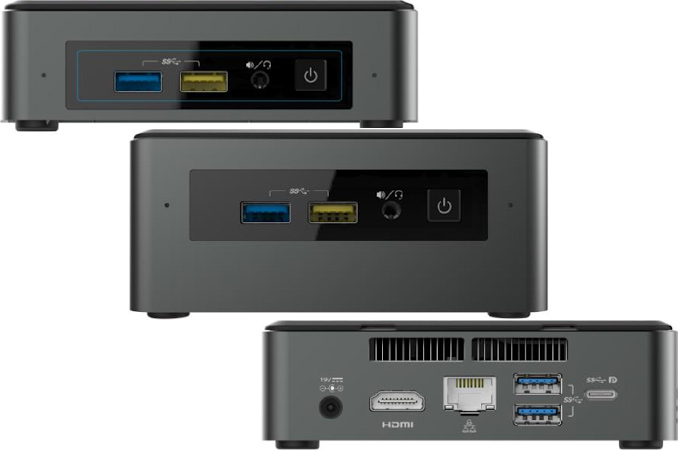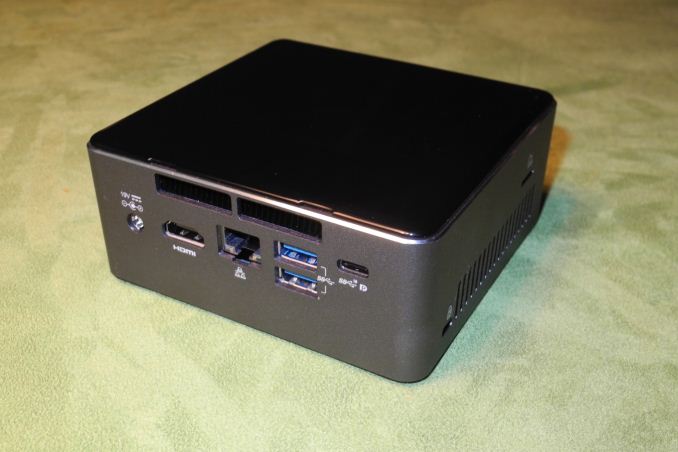Intel Officially Launches Baby Canyon NUCs with Kaby Lake: Thunderbolt Makes a Re-entry
by Ganesh T S on January 17, 2017 2:00 PM EST- Posted in
- Trade Shows
- Systems
- Intel
- HTPC
- NUC
- Thunderbolt 3
- Kaby Lake
- CES 2017

The Baby Canyon NUCs were leaked in July 2016, and Intel officially launched the units at CES 2017. The first-generation NUCs based on Ivy Bridge had a SKU with Thunderbolt support. However, Thunderbolt went missing till it came back in the Skull Canyon NUC (NUC6i7KYK) last year. The Alpine Ridge controller for Thunderbolt 3 also integrates a USB 3.1 Gen 2 controller, making the Type-C Thunderbolt 3 port quite versatile. The Baby Canyon NUCs bring Thunderbolt back into the UCFF NUC form-factor. All the Baby Canyon NUCs have the Alpine Ridge controller. However, the i3 model is limited by firmware, allowing the Type-C port to support only USB 3.1 Gen 2 and Display Port 1.2. The i7 and i5 models have full Thunderbolt 3 support.
The leaked specifications we wrote about in July were more or less accurate, and the official specifications allow us to fill in some of the missing blanks. The updated table is presented below. SKUs ending with K are units that do not support a 2.5" drive (only M.2 SSDs are supported).
| Intel Baby Canyon NUC PCs | |||||
| NUC7i7BNH | NUC7i5BNH | NUC7i5BNK | NUC7i3BNH | NUC7i3BNK | |
| CPU | Core i7-7567U 2C/4T 28 W TDP |
Core i5-7260U 2C/4T 15 W TDP |
Core i3-7100U 2C/4T 15 W TDP |
||
| Graphics | Intel Iris Plus Graphics 650 | Intel Iris Plus Graphics 640 | Intel HD Graphics 620 | ||
| PCH | Intel Sunrise Point-LP for Kaby Lake-U | ||||
| Memory | Two SO-DIMM slots, up to 32 GB of DDR4-2133 | ||||
| 2.5" bay | 1x2.5"/9.5mm bay, SATA3 | None | 1x2.5"/9.5 mm bay, SATA3 | None | |
| M.2 Slot | Up to M.2-2280 SSD with SATA3 or PCIe 3.0 x4 interface | ||||
| Wi-Fi/BT | Soldered-down Intel Wireless-AC 8265 (802.11ac 2x2 + BT 4.2) with WiDi support | ||||
| Ethernet | Intel I219V Gigabit Ethernet controller | ||||
| Display Outputs | DisplayPort 1.2 via USB-C connector HDMI 2.0 |
||||
| Audio | 3.5 mm TRRS audio jack 7.1 channel audio output via HDMI or DP |
||||
| Thunderbolt & USB-C |
1x Thunderbolt 3 Type-C (40 Gbps) (USB 3.1 Gen 2 and Display Port functionality included) | 1x USB 3.1 Gen 2 Type-C (with Display Port functionality included) | |||
| USB | 4 USB 3.0 Type-A (5 Gbps), one with charging | ||||
| Other I/O | MicroSDXC card reader with UHS-I support One infrared receiver |
||||
| Size (mm) | 115 × 111 × 51 | 115 × 111 × 31 | 115 × 111 × 51 | 115 × 111 × 31 | |
| PSU | External, 65 W | ||||
| OS | Compatible with Windows 7/8.1/10 | ||||
| Product Page | NUC7i7BNH Specifications | NUC7i5BNH Specifications | NUC7i5BNK Specifications | NUC7i3BNH Specifications | NUC7i3BNK Specifications |
In terms of appearance, the chassis sides now have a shade of gray to provide a better look when seen along with the black lid. We have a micro-SDXC slot on the side (a full-sized SDXC slot couldn't apparently work with their thermal design). In terms of performance, Kaby Lake should provide the claimed 7 - 11% improvement over the corresponding Skylake products. The new NUCs are also Optane-ready - allowing Optane M.2 SSDs to work seamlessly in conjunction with 2.5" hard drives in the future (when the Optane SSDs come into the market). One important thing to note here is that the i7 model uses a 28W TDP SKU (the Core i7-7567U), compared to the 15W TDP SKUs used in the i3 and i5 models. The i7 and i5 models have Iris Plus graphics with 64MB of eDRAM. None of the Baby Canyon NUCs support vPro. HDMI 2.0 with HDCP 2.2 is supported, thanks to the inclusion of a LSPCon in the BOM. This should make the units into perfect HTPCs with Netflix 4K capability. Compared to the NUCs from the last few generations, these units are not a big upgrade in terms of unique features for other use-cases. Generally speaking, we are not convinced that the Optane-ready feature is a big enough reason to upgrade to the Baby Canyon NUCs. That said, the i7 model should prove pretty interesting to compare against the Broadwell-U Iris NUC.
The NUC7i3BNH with the neutered Alpine Ridge Controller
(Note that the Type-C port only carries the SS10 / DP logos)
Intel indicated that the kits are slated to come into the market over the next few months at price points similar to the current Skylake versions. While official MSRPs were not provided, we see the NUC7i7BNH for pre-order at $700, the NUC7i5BNH at $610, and the NUC7i3BNH at $496.











70 Comments
View All Comments
Meteor2 - Wednesday, January 18, 2017 - link
I think TB3 has a place; external GPUs always spring to mind, or just moving lots of video (say if you're a vlogger).I'm surprised there's only one Type-C port, and that it's on the back.
MattMe - Wednesday, January 18, 2017 - link
I think it makes sense to have a TB3 port on the back - it'd typically be used for connecting screens or storage. A type C port on the front too would have been nice, especially if it were USB 3.1.Even if it were only on the larger chassis models.
TheinsanegamerN - Thursday, March 2, 2017 - link
I'd like to see smaller eGPU cages. Ones with a 75W limit and, say, low profile dual slot. Itd be a lot smaller to hide, and a lot cheaper for the end user.clixbou - Wednesday, January 18, 2017 - link
Any Kaby NUCs with drivers for Linux?(Professional software developers are looking for reasonable alternatives to Mac computers)
fanofanand - Wednesday, January 18, 2017 - link
Did they rename Iris Pro to Iris Plus? Or is this a different type of iGpu?MattMe - Saturday, January 28, 2017 - link
I think the Iris Plus is the models with 64mb edram, the Iris Pro is being saved for the 128mb models.spikebike - Thursday, January 19, 2017 - link
Anyone notice the pricing at random sites is radically better than the linked article. $700 for a barebones is pretty hard to swallow, but search for NUC7i7BNH and a bunch of sites have it for just slightly over $500. PC Connection is $500.88, shopblt $521.75.Not bad for (what intel claims) is a significant GPU upgrade from the previous skull canyon. I guess that's why the skull canyon has dropped from $650-$700 ish to $550.
I'll be watching for comparisons of the Iris 650 gpu.
falko2904 - Monday, January 23, 2017 - link
We use NUCs for business desktop PCs. And laptops do not compete. The standard setup for most people is either a single 20-24" monitor, or in many cases dual 20-24" monitors. And laptop keyboards do not hold up to serious typing, that requires a quality desktop keyboard. But my customers also do not wish to have a boat anchor occupying their office space. So NUC it is. And though I have checked out other NUC like solutions, the aluminum chassis speaks of quality that the customer appreciates. I have one at home as a media center PC that is the center of my entertainment system. Low power consumption, virtually noiseless, and more flexibility than a cable box or streaming box. I do everything at home with that and a 120" projector screen.MattMe - Saturday, January 28, 2017 - link
Almost exactly the same situation here. NUCs are great desktop replacements for the office and offer fair pricing in my opinion; desktops with good SSDs, 8GB RAM and the same CPU spec cost similar, and with the NUC you get the benefit of hanging off the back of a screen too.People seem to overlook the fact they put the good spec 'U' CPUs in them too, not just the base models.
Silma - Monday, January 23, 2017 - link
NUCs would be great if not that expensive.I'll base my next HTPC on the Up2 (http://www.up-board.org/upsquared/), whose main disadvantage is HDMI 1.4b, so no Netflix 4K.
But so much cheaper.